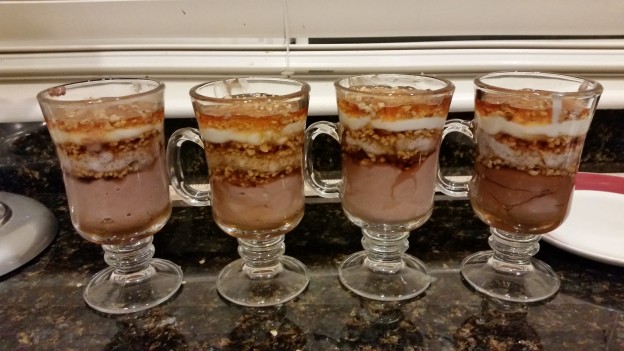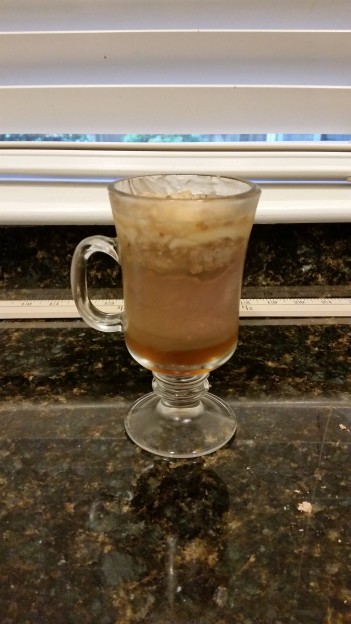Monday, November 16, 2015 – Something a little different this time. My friend Spiro picked rose water, honey, nuts, cinnamon, and chocolate. Now, the rose water, honey, and nuts immediately screams baklava. Which was too obvious, so I didn’t want to do that. In fact, I figured I’d avoid the whole pastry thing altogether. So my next thought was pudding.
The next problem, of course, is that rose water, cinnamon, and chocolate don’t really blend as flavors. So instead of making one pudding, I’d make three. And I’d layer the honey and nuts in between them. And call it a parfait.
Unfortunately, what actually happened was that the rose water separated from the pudding and made everything soggy (yes, pudding can apparently be soggy), and the honey ended up sinking to the bottom. While soggy pudding still tastes fine, it does have a weird texture to it. And while honey is delicious, having to eat a big glob of it is a little overkill.
If I were to do it over again (and I plan on doing it over again), I may have to go the pastry route. I’m still not going to recreate baklava plus cinnamon and chocolate though. I’m thinking a puff pastry roll (like a croissant, except I’m buying puff pastry from the grocery store) filled with chocolate and nuts, soaked rose water, glazed with honey, with a sprinkle of cinnamon. Or something like that. More on that next month.
That said, I still want to give you my pudding recipe, since I’ve never given it before. (I synthesized it from several recipes on line, then experimented around with it.)
Ingredients
750g (3 cups) whole milk
100g (1/2 cup) sugar
35g (1/4 cup) cornstarch
pinch salt
1 Tbsp cold butter
One of these flavorings:
- one 1/2 oz square of chocolate (recommend something super dark, like Lindt 90%)
- 1 Tbsp vanilla paste
Instructions
- Add milk to a shallow, wide saute pan (frying pan with high sides) on medium heat. Add sugar, cornstarch, and salt.
- Bring milk mixture to a boil, then reduce to a simmer. Let simmer until the mixture is thick and coats the back of a spoon and forms ribbon trails, about 30 min.
- Melt in butter. Add (or melt in) your flavorings. Remove from heat and stir for an additional 2 min.
- Cover in plastic wrap, with plastic directly in contact with pudding, and let cool. (Ideally in the fridge overnight.)
You can make this recipe go faster by reducing the amount of milk, or increasing the amount of cornstarch, but that will make the pudding a bit thicker.
As for the ribbon trails, if you don’t know what ribbon trails are, it’s when you pour the mixture from a spoon, and it comes out in a continuous stream. If it drips like a leaky faucet, it’s too thin. If it doesn’t flow at all, it’s too thick. At this point, it might look too thin, but when you let it cool (especially in the fridge overnight), it will solidify into something nice and pudding-ish.
For the chocolate, they say to use chocolate you would actually eat, but you might be able to get away with baker’s chocolate. That and most people don’t eat super dark chocolate. Here, we want to use something super dark, since our base already has a lot of milk and sugar, so concentrated chocolate flavor is the way we want to go. (Really, the best way to go is to buy a brand you would eat, but buy more concentrated stuff.)
For the vanilla, we use vanilla paste instead of vanilla extract. Since you put in the vanilla at the very end, the alcohol won’t burn off, so it will make your pudding taste really boozy. (Unless that’s what you like.) Plus, I always felt like vanilla paste had more flavor. Why not imitation vanilla? Again, since you’re adding the vanilla at the very end, we won’t burn off all the subtle flavors, so we can use better stuff.
And in case you’re wondering, yes, cinnamon pudding works. You’ll want 1 Tbsp cinnamon to 1 tsp nutmeg. And just like with the other flavorings, you’ll want to add these at the end.
Bonus: Let’s talk about rose water. On the right is rose water extract, which is rose water oils in alcohol. (Similar to vanilla extract or peppermint extract.) I got the rose water extract at Uwajimaya. This is better if you want to infuse rose water flavor into something without adding extra moisture, but it’s not traditional rose water.
On the left is actual rose water, which I got from Whole Foods. This is what I used in the pudding (and it didn’t work out), and this is what I’ll use when I make my Ingredient Challenge #5, Take 2.



